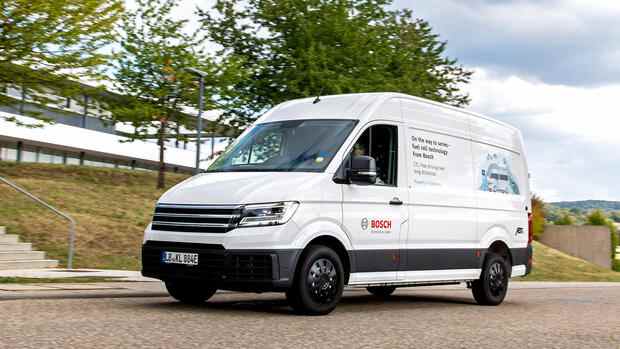The transporter should have a range of 500 kilometers with ten kilos of hydrogen.
Stuttgart The movement of goods should become emission-free – and currently the answer to this problem seems to be the battery-powered van. At the IAA Commercial Vehicles alone, which starts next week in Hanover, numerous electrical innovations are to be presented. Just a few days ago, Mercedes announced that it would build vans together with its US partner Rivian from 2025. It attracts a billion dollar market.
However, according to Bosch, electric transporters have a crucial weakness: They are heavy and have a high level of air resistance due to their height. “The additional costs for fully electric vans are immense,” Mathias Geisen, head of the van division at Mercedes, recently admitted to the Handelsblatt.
Batteries used in vehicles such as the E-Sprinter, which is more than six meters long and 2.7 meters high, are many times larger and heavier than those used in conventional cars. The batteries currently available from many manufacturers usually only allow a range of less than 200 kilometers, depending on the conditions.
The world’s largest automotive supplier therefore wants to position its fuel cell as an alternative with a longer range. The Swabians quickly bought two electric transporters on the market, threw out the large battery and housed a fuel cell including peripherals, five storage tanks for a total of over ten kilograms of hydrogen and a smaller lithium-ion battery in the same space.
Top jobs of the day
Find the best jobs now and
be notified by email.
The vehicles are street legal. The partner in the project is ABT e-Line GmbH, which designed and built the conversion of the vehicles with Bosch components together with Bosch Engineering.
The whole thing should be far more than just an eye-catcher for the trade fair. “The fuel cell enables long ranges and short refueling times, which makes long journeys more economical,” says Markus Heyn, who heads the mobility division at Bosch with sales of over 40 billion euros. “With the two fuel cells, we are showing that the fuel cell can also be a suitable drive solution for light commercial vehicles.”
Data from the test vehicles recorded in real time should help the developers to continuously improve the systems. Many components are already included that Bosch already produces in series.
Fuel cells are expensive
The additional costs of more than 10,000 euros currently make fuel cell cars far too expensive to compete with purely electric cars. The industry therefore agrees that the fuel cell will have a chance, especially in trucks. For commercial use, the additional costs are easier to absorb.
In addition, commercial traffic is not dependent on such a dense network of filling stations. Because for many customers, the lack of a hydrogen infrastructure is still a reason to decide against a vehicle with a fuel cell. “Industry and politics must work together to remove obstacles to hydrogen technologies,” demands Bosch drive boss Uwe Gackstatter. This particularly affects the industrial production of green hydrogen.
>> Also read: Inside Nikola – How the start-up still wants to revolutionize the truck world
However, Bosch is convinced that the fuel cell will become an alternative to purely battery-powered electric cars. The technology-savvy new Bosch boss Stefan Hartung increased investments in fuel cell technology to one billion euros just a few weeks after taking office. The smaller commercial vans will become a battle zone as the fuel cell gets close to the cars. It attracts higher quantities than the heavy trucks.
Instead of batteries, Bosch relies on hydrogen in the van.
The know-how already acquired by Bosch is also to be used in hydrogen production. As in the fuel cell, the stack, i.e. the stack of several hundred individual cells, also forms the central element in the electrolyser. In each of the cells connected in series, water is converted into hydrogen and oxygen with the help of electricity – in reverse to the fuel cell, in which hydrogen and oxygen are used to generate electrical energy.
In any case, according to Bosch, ranges of more than 500 kilometers are no problem with fuel cells, even with fully loaded vans. And you can fill up within six minutes. For fleet operators whose vans cover particularly long distances during the day and return to the depot in the evening, Bosch is convinced that the fuel cell can be a good supplement to the battery-electric drive in the future.
More: BMW is bucking the trend on hydrogen – and that’s smart
